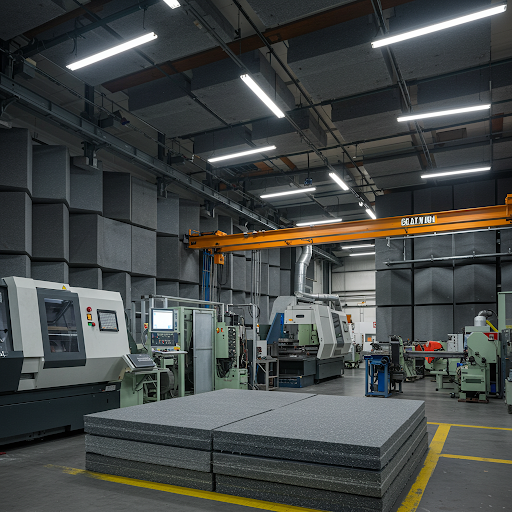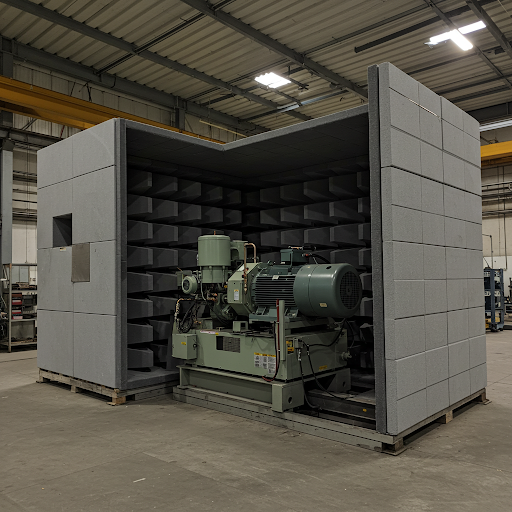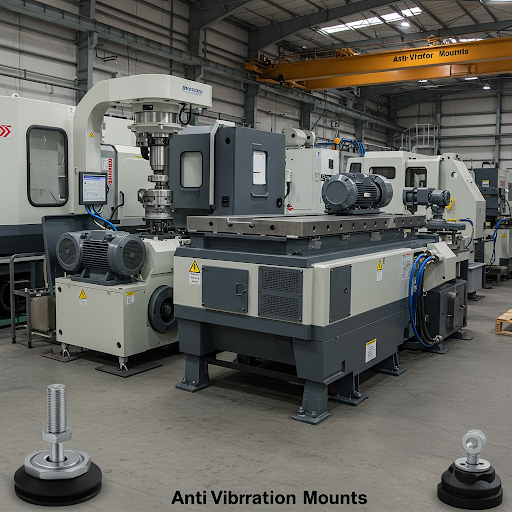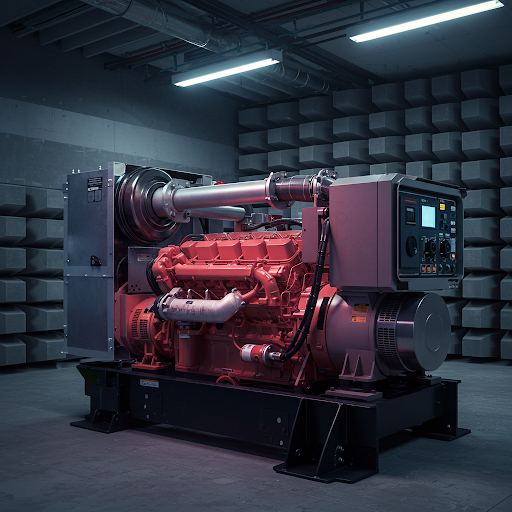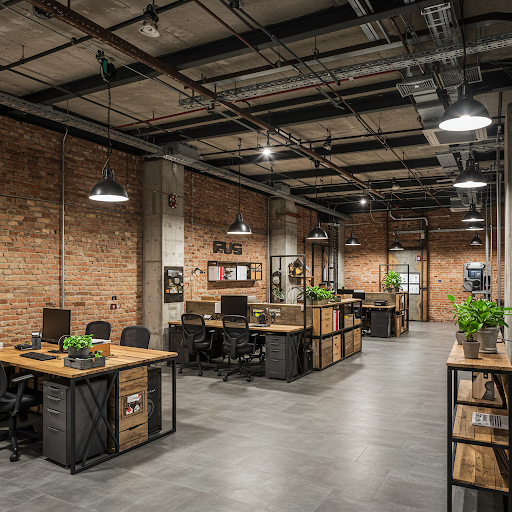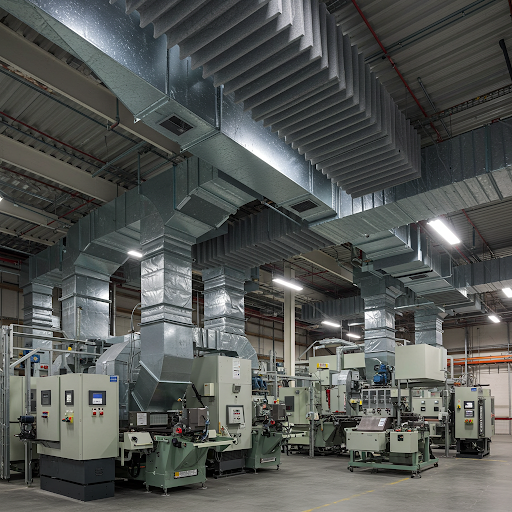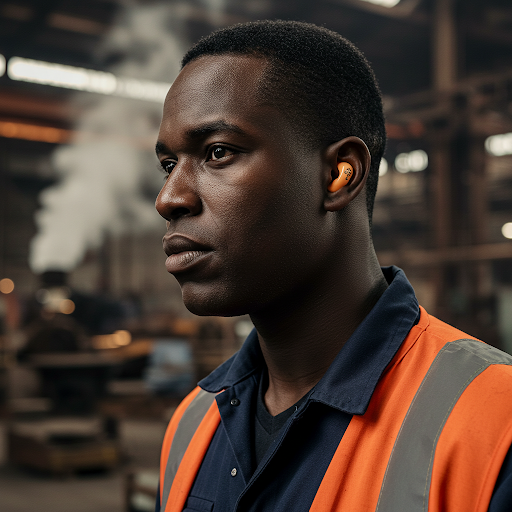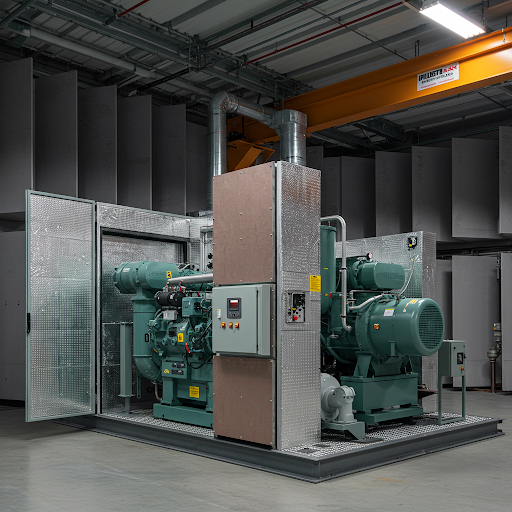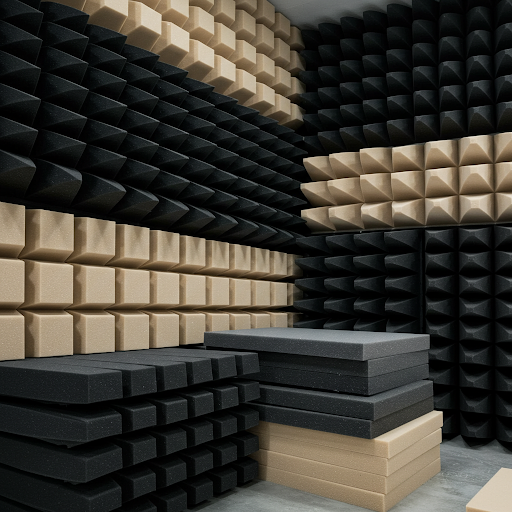Description
In Nairobi, Kenya, the regulation of industrial sound insulation is primarily governed by the Environmental Management and Coordination Act (EMCA). And the Noise and Excessive Vibration Pollution (Control) Regulations of 2009. These legal instruments aim to protect public health, ensure environmental tranquility, and maintain a healthy environment for all residents of Nairobi.
Permissible Noise Levels
The regulations establish maximum permissible noise levels for different zones, including industrial areas. And at different times of the day (day and night). These limits are outlined in the First Schedule of the Noise and Excessive Vibration Pollution (Control) Regulations, 2009.
For industrial areas, higher noise levels are generally permitted during the daytime compared to residential or sensitive areas like hospitals and schools. Noise levels are significantly restricted during nighttime hours in all zones in Nairobi to minimize disturbance.
General Prohibitions
The regulations prohibit any person in Nairobi from making or causing “loud, unreasonable, unnecessary or unusual noise”. Unusual noise annoys, disturbs, injures, or endangers the comfort, repose, health, or safety of others and the environment. Factors considered in determining if noise falls under this category include the time of day and the proximity to residential areas. As well as the nature of the noise (recurrent, intermittent, or constant). The noise level and intensity, and whether it can be controlled without undue effort or expense, are also considered.
Licensing and Permits
Industries in Nairobi likely to emit noise or excessive vibrations beyond the permissible levels are required to obtain a license or permit from the National Environment Management Authority (NEMA) or relevant county government authorities. The application process and conditions for these licenses are detailed in the regulations.
Noise Measurement and Control
NEMA, in consultation with other relevant lead agencies, is responsible for measuring and controlling noise levels in Nairobi. They may issue guidelines for noise and vibration measurement. Industries are expected to implement noise abatement measures to comply with the set standards.
Enforcement
While NEMA has the overall mandate, county governments in Kenya play a significant role in enforcing these noise regulations. Violators may face penalties, including fines and even the closure of business premises in severe cases of non-compliance.
Workplace Engineering Controls of Industrial Sound Insulation
It’s important to note that these regulations apply to workplaces in Nairobi. And do not negate the Factories and Other Places of Work (Noise Prevention and Control) Rules, 2005, which specifically address noise exposure in occupational settings.
Therefore, industrial facilities in Nairobi must adhere to these regulations. And implement effective sound insulation and noise control measures to protect their workers and the surrounding community from excessive noise pollution. Consulting with Wallpaper Kenya’s acoustic engineers is advisable to ensure compliance and implement appropriate solutions.
Industrial sound insulation is the process and materials used to reduce noise levels in industrial settings. These settings often involve heavy machinery and processes that generate significant amounts of noise. Industrial noise can be harmful to workers’ hearing and the surrounding environment. Effective industrial sound insulation aims to create a safer and more comfortable working environment, comply with noise regulations, and minimize noise pollution.
Here’s a breakdown of key aspects of industrial sound insulation:
Why is Industrial Sound Insulation Important?
Worker Health and Safety
In Nairobi’s industrial settings, prolonged exposure to high noise levels poses significant health risks.
Workers face potential noise-induced hearing loss, increased stress and fatigue, and diminished concentration. These factors collectively elevate the risk of workplace accidents, highlighting the critical need for effective industrial soundproofing measures in Nairobi to protect worker well-being and safety.
Environmental Protection
In Nairobi, excessive industrial noise extends its impact beyond human health. It can disrupt local wildlife communication, foraging, and breeding behaviors, potentially leading to habitat avoidance and reduced populations. Ecosystems can be affected through altered species interactions. Furthermore, constant loud noise diminishes the quality of life for communities living near industrial zones in Nairobi. And this causes annoyance, sleep disturbances, and stress, impacting the overall well-being of residents.
Productivity and Communication
In Nairobi’s industrial workplaces, high noise levels significantly impede clear communication among employees. This breakdown in verbal exchange can lead to misunderstandings, errors in tasks, and delays in operations, ultimately resulting in a decrease in overall productivity and efficiency within the Nairobi facility. Effective soundproofing is crucial for fostering a more communicative and productive work environment.
Community Relations
Controlling noise pollution helps maintain positive relationships with the surrounding community.
Methods and Materials for Industrial Sound Insulation
Industrial sound insulation often involves a combination of strategies that address the noise source, the transmission path, and the receiver. Common methods and materials include:
1. Sound Absorption
Acoustic Panels
These acoustic panels, constructed from sound-absorbent materials such as fiberglass, mineral wool, foam, or recycled PET, work by trapping sound waves. This absorption action significantly reduces the reflection of sound within a room, minimizing reverberation and echo.
Consequently, the overall noise level and clarity of sound within the space are improved, making them a common solution for walls and ceilings in noisy environments.
Acoustic Baffles and Banners
Acoustic baffles and banners, hung from the ceiling, provide an effective way to boost sound absorption in expansive industrial settings.
By increasing the total surface area of sound-absorbing material within the volume of the space, these suspended treatments capture and dissipate sound waves that would otherwise reflect off hard surfaces. This reduces overall noise levels and improves the acoustic environment, particularly in areas with high ceilings.
Acoustic Foam
In Nairobi, acoustic foam, available in diverse shapes and thicknesses, is a versatile sound-absorbing material for industrial settings. Applying it to walls, ceilings, and directly to machinery in Nairobi helps to reduce reverberation and overall noise levels by trapping sound waves within its porous structure.
This improves sound clarity and creates a less noisy work environment in Nairobi.
Quilted Absorbers
Quilted absorbers are flexible blankets engineered with sound-absorbing materials.
Their versatility allows them to serve as temporary sound barriers to isolate noisy areas or as permanent components of enclosures around machinery.These blankets effectively dampen sound waves, reducing noise transmission and reverberation, offering a practical solution for noise control in various industrial applications where flexibility and adaptability are needed.
2. Sound Blocking (Sound Transmission Loss)
Mass Loaded Vinyl (MLV)
In Nairobi’s industrial soundproofing, mass-loaded vinyl (MLV) is a dense, flexible material highly effective at blocking sound wave transmission.
Its significant mass provides a substantial barrier when incorporated into walls, ceilings, and machinery enclosures in Nairobi. And reduces noise transfer between spaces, thus containing industrial noise effectively within the Nairobi environment.
Soundproof Doors and Windows
In Nairobi, soundproof doors and windows are specialized installations designed to minimize noise transmission into or out of industrial facilities. Featuring dense cores, multiple layers of glazing, and tight seals, they significantly reduce the passage of airborne sound. These are crucial in Nairobi for creating quiet work zones and complying with noise regulations affecting surrounding communities.
Acoustic Enclosures
In Nairobi, acoustic enclosures are custom-built structures surrounding noisy industrial machinery to contain sound at its source. Constructed from materials like metal, wood, or composites, they incorporate sound-absorbing linings such as foam or mineral wool to further reduce noise levels. These enclosures are vital for creating quieter workplaces and minimizing noise pollution affecting nearby areas, while complying with local regulations.
Sound Barriers
In Nairobi’s industrial settings, sound barriers are walls or partitions made from dense materials like concrete, metal, or specialized acoustic panels. Strategically placed, they effectively block the direct path of sound emanating from machinery, reducing noise levels reaching workers or neighboring areas in Nairobi.
These barriers are a key component of noise control strategies in Nairobi.
3. Vibration Damping and Isolation
Vibration isolation mounts and pads are crucial components placed beneath industrial machinery to minimize the transfer of vibrations to the floor and surrounding structure.
Typically made of elastomeric materials like rubber or neoprene, they act as a buffer. They absorb and dissipate the kinetic energy produced by operating equipment. By decoupling the machinery from the building, these mounts prevent structure-borne noise. And reduce wear and tear on both the equipment and the facility itself. Thereby contributing to a quieter and more stable industrial environment.
Damping Compounds and Sheets
The damping compounds and sheets are applied directly to vibrating surfaces of industrial machinery, such as housings or panels. These materials work by absorbing and dissipating the vibrational energy, effectively reducing resonance – the tendency of a material to vibrate intensely at certain frequencies. By minimizing these vibrations, damping treatments significantly decrease the amount of noise radiated from the equipment’s surfaces, contributing to a quieter workspace.
Pipe and Duct Lagging
In Nairobi, wrapping noisy industrial pipes and ducts with specialized acoustic lagging involves layering sound-absorbing materials (like fiberglass) and sound-blocking materials (like mass-loaded vinyl). This technique effectively reduces both airborne noise radiating from the surfaces and structural vibrations transmitted through the pipes and ducts within Nairobi’s industrial facilities.
4. Acoustic Sealants and Caulks
Acoustic sealants and caulks are crucial for achieving effective sound insulation. These specialized, flexible compounds are specifically designed to create airtight and sound-resistant seals in the numerous small gaps, cracks, and openings that are often present in walls, floors, ceilings, and around penetrations for doors, windows, pipes, and ductwork. Even small unsealed areas can act as significant pathways for sound to leak through, effectively bypassing the sound-blocking properties of solid materials.
By meticulously applying acoustic sealants, these sound leaks are eliminated, ensuring the integrity of the sound barrier. This seemingly minor detail plays a vital role in maximizing the performance of other sound insulation measures, such as mass-loaded vinyl, acoustic panels, and soundproof doors. Without proper sealing, the overall soundproofing effectiveness of a structure or enclosure can be significantly compromised, rendering other investments less impactful. Therefore, acoustic sealants are an indispensable component of any comprehensive industrial sound insulation strategy, ensuring that sound transmission is effectively minimized through all potential pathways.
Key Considerations for Industrial Sound Insulation
Noise Source Analysis
A thorough analysis of the industrial noise source – its intensity (level), the range of its sound components (frequency), and how long it persists (duration) – is fundamental. This detailed understanding dictates the selection of suitable sound insulation materials with appropriate absorption and blocking properties effective across the relevant frequency spectrum and capable of handling the noise level and exposure time. Accurate assessment ensures targeted and cost-effective noise control strategies.
Environmental Factors
In Nairobi’s diverse industrial environments, material selection for soundproofing must consider local conditions. High temperatures, humidity, and potential chemical exposure in Nairobi can degrade certain acoustic materials over time. Therefore, choosing durable, resistant materials suitable for Nairobi’s specific industrial challenges is crucial for long-term soundproofing effectiveness and cost-efficiency.
Fire Safety
In many industrial environments, the presence of flammable materials, high temperatures, and potential ignition sources necessitates the use of fire-rated sound insulation. These specialized materials are designed to resist burning, limit flame spread, and minimize smoke generation, crucial for preventing or slowing down the spread of fire. Compliance with building codes and safety regulations often mandates the use of such fire-resistant materials to protect personnel and assets in case of a fire incident.
Maintenance and Durability
The chosen materials should be able to withstand the industrial environment and be easy to maintain.
Cost-Effectiveness
Balancing the required level of noise reduction with the budget is important.
Installation
Even the highest-quality sound insulation materials will fail to perform optimally if not installed correctly. Gaps, insufficient sealing, improper layering, or inadequate support can create sound leaks and reduce the intended noise reduction. Skilled and knowledgeable installation ensures that materials are applied according to specifications, maximizing their sound-absorbing and sound-blocking capabilities, and ultimately achieving the desired noise control outcomes in the industrial environment.
Hierarchy of Noise Control
When addressing industrial noise, a hierarchy of controls is often recommended:
Elimination
Eliminating the industrial noise source is the most effective noise control measure. This involves identifying the root cause of the excessive sound and finding ways to avoid generating it altogether. Examples include redesigning processes to use quieter technologies, opting for alternative production methods that produce less noise, or even discontinuing particularly noisy operations if feasible without impacting core functions.
This proactive approach prevents noise pollution at its origin, offering the most sustainable and impactful solution.
Substitution
Substitution involves identifying loud machinery or processes and replacing them with quieter alternatives that perform the same function. This could mean investing in newer, more technologically advanced equipment designed with noise reduction features, opting for different types of machinery that inherently produce less sound, or modifying existing equipment with quieter components. This proactive measure directly reduces noise generation at the source, creating a less hazardous and more comfortable work environment.
Engineering Controls
Engineering controls involve physical modifications to the workplace or equipment to reduce noise transmission.
This includes implementing sound insulation strategies like acoustic enclosures around machinery, installing sound barriers to block noise paths, and applying sound-absorbing materials to surfaces to reduce reverberation. These measures aim to create a quieter environment for a larger group of workers by directly altering the physical pathways of sound.
Administrative Controls
Changing work schedules or procedures to limit noise exposure.
Personal Protective Equipment (PPE)
Providing hearing protection, like earplugs or earmuffs, is a last resort.
By carefully assessing the noise problem and implementing appropriate sound insulation strategies, industries can significantly reduce noise levels, creating healthier, safer, and more productive environments while minimizing their impact on the surrounding community.

